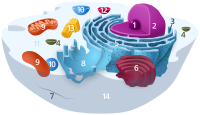
Photo from wikipedia
Age-related neurodegenerative diseases are of critical concern to the general population and research/medical community due to their health impact and socioeconomic consequences. A feature of most, if not all, neurodegenerative… Click to show full abstract
Age-related neurodegenerative diseases are of critical concern to the general population and research/medical community due to their health impact and socioeconomic consequences. A feature of most, if not all, neurodegenerative disorders is the presence of proteinopathies, in which misfolded or conformationally altered proteins drive disease progression and are often used as a primary neuropathological marker of disease. In particular, Alzheimer's disease (AD) is characterized by abnormal accumulation of protein aggregates, primarily extracellular plaques composed of the Aβ peptide and intracellular tangles comprised of the tau protein, both of which may indicate a primary defect in protein clearance. Protein degradation is a key cellular mechanism for protein homeostasis and is essential for cell survival but is disrupted in neurodegenerative diseases. Dysregulation in proteolytic pathways - mainly the autophagic-lysosomal system (A-LS) and the ubiquitin-proteasome system (UPS) - has been increasingly associated with proteinopathies in neurodegenerative diseases. Here we review the role of dysfunctional autophagy underlying AD-related proteinopathy and discuss how to model this aspect of disease, as well as summarize recent advances in translational strategies for targeted A-LS dysfunction in AD.
Journal Title: Neuroscience Letters
Year Published: 2019
Link to full text (if available)
Share on Social Media: Sign Up to like & get
recommendations!